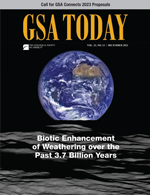Abstract View
Volume 32 Issue 12 (December 2022)
GSA Today
Article, p. 4-9 | Full
Text
| PDF
Biotic Enhancement of Weathering over the Past 3.7 Billion Years
Gregory J. Retallack
Dept. of Earth Sciences, University of Oregon, Eugene, Oregon 97403-1272, USA, gregr@uoregon.edu
Abstract
Over the past four billion years, our sun became 30% brighter, yet Earth’s water has neither
completely frozen nor boiled off during that time. A theoretical solution to this paradox is a
carbon dioxide greenhouse planetary thermostat regulated by evolutionary advances in
biologically mediated silicate and apatite weathering. This carbon sequestration history can now
be quantified using paleosols. Calculations of precipitation-normalized nutrient depletion rates
(µmol mm–1 a–1) in paleosols ranging in age back to 3.7 Ga show discrete
order of magnitude increases in carbon consumption by silicate and apatite weathering due to
evolutionary advances in life on land at around the Great Oxidation Event (2.45 Ga) and
Neoproterozoic Oxidation Event (0.8 Ga). This biological weathering countered increased solar
luminosity and continued emission of volcanic greenhouse gases.
Manuscript received 15 Apr. 2022. Revised manuscript received 10 June 2022.
Manuscript accepted 17 June 2022. Posted 14 July 2022.
© The Geological Society of America, 2022. CC-BY-NC.
https://doi.org/10.1130/GSATG543A.1
Cover Image

Search Google Scholar for
Search GSA Today
